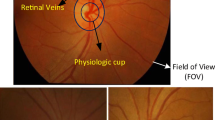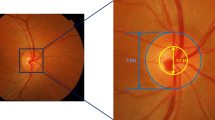Abstract
Recently, automated retinal image processing has been considered a competitive field of research due to the low-accuracy results, complexity, and unacceptable outcomes associated with it. In this article, we proposed a novel approach for the classification of fundus images from different kinds of fundus disorders. The original images are preprocessed in terms of noise and contrast enhancement by using the contrast limited adaptive histogram equalization method. The optic cup segmentation from the fundus images is effectively handled via the search and rescue optimization algorithm. After that, the color, texture, and shape-based gray-level co-occurrence matrix features are extracted. The hybrid particle swarm optimization with local search strategy improves the DNN parameter and the newly developed method is named as optimal DNN. The optimal DNN is used to classify whether the image is diabetic retinopathy, glaucoma, or age-related macular degeneration. Experimentally, different kinds of datasets such as STARE, Drishti, and RIM-One datasets with performance measure are validated. Finally, the proposed approaches demonstrate higher classification performances in terms of accuracy, specificity, sensitivity, precision, recall, and f-measure.







Similar content being viewed by others
Explore related subjects
Discover the latest articles and news from researchers in related subjects, suggested using machine learning.References
Shen Y, Sheng B, Fang R, Li H, Dai L, Stolte S, Qin J, Jia W, Shen D (2020) Domain-invariant interpretable fundus image quality assessment. Med Image Anal 61:101654
Shankar K, Zhang Y, Liu Y (2020) Wu and Chen (2020) Hyperparameter tuning deep learning for diabetic retinopathy fundus image classification. IEEE Access 8:118164–118173
Sakaguchi A, Wu R, Kamata S (2019) Fundus image classification for diabetic retinopathy using disease severity grading. In: Proceedings of the 2019 9th international conference on biomedical engineering and technology, pp 190–196
Mateen M, Wen J, Song S, Huang Z (2019) Fundus image classification using VGG-19 architecture with PCA and SVD. Symmetry 11(1):1
Meng Q, Hashimoto Y, Satoh S (2019) Fundus image classification and retinal disease localization with limited supervision. In: Asian conference on pattern recognition, pp 469–482
Ghani A, See CH, Sudhakaran V, Ahmad J, Abd-Alhameed R (2019) Accelerating retinal fundus image classification using artificial neural networks (ANNs) and reconfigurable hardware (FPGA). Electronics 8(12):1522
Qureshi I, Ma J, Shaheed K (2019) A hybrid proposed fundus image enhancement framework for diabetic retinopathy. Algorithms 12(1):14
Choi D, Cho H, Rhee W (2018) On the difficulty of DNN hyperparameter optimization using learning curve prediction. In: TENCON 2018–2018 IEEE region 10 conference, pp 0651–0656
Sundararaj V (2019) Optimised denoising scheme via opposition-based self-adaptive learning PSO algorithm for wavelet-based ECG signal noise reduction. Int J Biomed Eng Technol 31(4):325
Sundararaj V, Muthukumar S, Kumar RS (2018) An optimal cluster formation based energy efficient dynamic scheduling hybrid MAC protocol for heavy traffic load in wireless sensor networks. Comput Secur 77:277–288
Rejeesh MR (2019) Interest point based face recognition using adaptive neuro fuzzy inference system. Multimed Tools Appl 78(16):22691–22710
Vinu S (2016) An efficient threshold prediction scheme for wavelet based ECG signal noise reduction using variable step size firefly algorithm. Int J Intell Eng Syst 9(3):117–126
Sundararaj V, Anoop V, Dixit P, Arjaria A, Chourasia U, Bhambri P, Rejeesh MR, Sundararaj R (2020) CCGPA-MPPT: Cauchy preferential crossover-based global pollination algorithm for MPPT in photovoltaic system. Prog Photovolt 28(11):1128–1145
Vinu S (2019) Optimal task assignment in mobile cloud computing by queue based ant-bee algorithm. Wirel Pers Commun 104(1):173–197
Ravikumar S, Kavitha D (2020) IoT based home monitoring system with secure data storage by Keccak-Chaotic sequence in cloud server. J Ambient Intell Human Comput. https://doi.org/10.1007/s12652-020-02424-x
Kavitha, D. and Ravikumar, S., 2020. Designing an IoT based autonomous vehicle meant for detecting speed bumps and lanes on roads. J Ambient Intell Humanized Comput 1–10
Kavitha D, Ravikumar S (2021) IOT and context-aware learning-based optimal neural network model for real-time health monitoring. Trans Emerg Telecommun Technol 32(1):e4132
Ravikumar S, Kavitha D, (2021) IOT based autonomous car driver scheme based on ANFIS and black widow optimization. J Ambient Intell Humanized Comput: 1–14
Albert P, Nanjappan M (2020) An efficient kernel FCM and artificial fish swarm optimization-based optimal resource allocation in cloud. J Circ Syst Comput 29(16):2050253
Juneja M, Thakur N, Thakur S, Uniyal A, Wani A, Jindal P (2020) GC-NET for classification of glaucoma in the retinal fundus image. Mach Vis Appl 31(5):1–18
Sathya N, Rathika N (2020) Different classification methods of fundus image segmentation using quincunx wavelet decomposition. J Ambient Intell Hum Comput 1–7
Pruthi J, Khanna K, Arora S (2020) Optic Cup segmentation from retinal fundus images using Glowworm Swarm Optimization for glaucoma detection. Biomed Signal Process Control 60:102004
Jang Y, Son J, Park KH, Park SJ, Jung K-H (2018) Laterality classification of fundus images using interpretable deep neural network. J Digit Imaging 31(6):923–928
Badgujar and Deore (2019) Hybrid nature inspired SMO-GBM classifier for exudate classification on fundus retinal images. IRBM 40(2):69–77
Shabani A, Asgarian B, Salido M, Gharebaghi SA (2020) Search and Rescue optimization algorithm: a new optimization method for solving constrained engineering optimization problems. Expert Syst Appl 113698
Takahama T, Sakai S (2006) Constrained optimization by the ε constrained differential evolution with gradient-based mutation and feasible elites. In: 2006 IEEE international conference on evolutionary computation, pp 1–8
Ongun H, Leblebicioglu A, Beksaç M, S, Beksaç (2001) Feature extraction and classification of blood cells for an automated differential blood count system. Int Joint Conf Neural Netw Proc 4:2461–2466
Masoomi Z, Mesgari MS, Hamrah M (2013) Allocation of urban land uses by multi-objective particle swarm optimization algorithm. Int J Geogr Inf Sci 27(3):542–566
Liu Z, Qin Z, Zhu P, Li H (2020) An adaptive switchover hybrid particle swarm optimization algorithm with local search strategy for constrained optimization problems. Eng Appl Artif Intell 95:103771
Niu B, Li L (2008) A novel PSO-DE-based hybrid algorithm for global optimization. In: International conference on intelligent computing, pp 156–163
Mehta SS, Martinez S, Grossman EA, Thayer B, Bullock D, Neary J (2014) Synchronization and switch over methods and systems for an adaptive audio system, U.S. Patent, p 8,838,262
Xiang Z, Miller DJ, Kesidis G (2020) Revealing backdoors, post-training, in DNN classifiers via novel inference on optimized perturbations inducing group misclassification. In: ICASSP 2020–2020 IEEE international conference on acoustics, speech and signal processing (ICASSP), pp 3827–3831
Martínez SZ, Coello CAC (2012) A direct local search mechanism for decomposition-based multi-objective evolutionary algorithms. In: 2012 IEEE congress on evolutionary computation, pp 1–8
Guo Y, Budak Ü, Şengür A, Smarandache F (2017) A retinal vessel detection approach based on shearlet transform and indeterminacy filtering on fundus images. Symmetry 9(10):235
Badar M, Haris M, Fatima A (2020) Application of deep learning for retinal image analysis: a review. Comput Sci Rev 35:100203
Fumero F, Alayón S, Sanchez JL, Sigut J, Gonzalez-Hernandez M (2011) RIM-ONE: an open retinal image database for optic nerve evaluation. In 2011 24th International symposium on computer-based medical systems (CBMS), pp 1–6
Dorigo M, Stützle T (2019) Ant colony optimization: overview and recent advances. In: Handbook of metaheuristics, pp 311–351
Kaur S, Awasthi LK, Sangal AL, Dhiman G (2020) Tunicate Swarm Algorithm: a new bio-inspired based metaheuristic paradigm for global optimization. Eng Appl Artif Intell 90:103541
Pan X, Zhang Q, H, Pan, (2020) Improved artificial bee colony algorithm and its application to fundus retinal blood vessel image binarization. IEEE Access 8:123726–123734
Kavithaand M, Palani S (2015) Hierarchical classifier for soft and hard exudates detection of retinal fundus images. J Intell Fuzzy Syst 27(5):2511–2528
Popescu D, Ichim L, Caramihale (2015) Texture based method for automated detection, localization and evaluation of the exudates in retinal images. In: Neural information processing, pp 463–472
Martins J, Cardoso JS, F, Soares (2020) Offline computer-aided diagnosis for Glaucoma detection using fundus images targeted at mobile devices. Comput Methods Programs Biomed 192:105341
Author information
Authors and Affiliations
Corresponding author
Ethics declarations
Conflict of interest
The authors declare that they have no conflict of interest.
Human and animal rights
This article does not contain any studies with human or animal subjects performed by any of the authors.
Informed consent
Informed consent was obtained from all individual participants included in the study.
Additional information
Publisher's Note
Springer Nature remains neutral with regard to jurisdictional claims in published maps and institutional affiliations.
Rights and permissions
About this article
Cite this article
Ramya, J., Rajakumar, M.P. & Uma Maheswari, B. HPWO-LS-based deep learning approach with S-ROA-optimized optic cup segmentation for fundus image classification. Neural Comput & Applic 33, 9677–9690 (2021). https://doi.org/10.1007/s00521-021-05732-1
Received:
Accepted:
Published:
Issue Date:
DOI: https://doi.org/10.1007/s00521-021-05732-1




